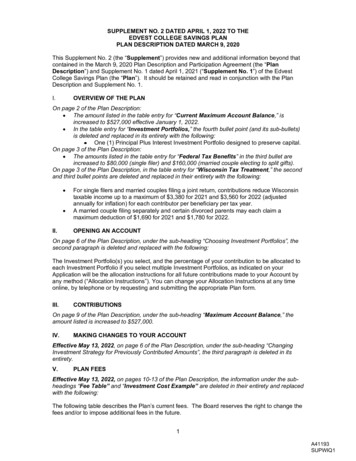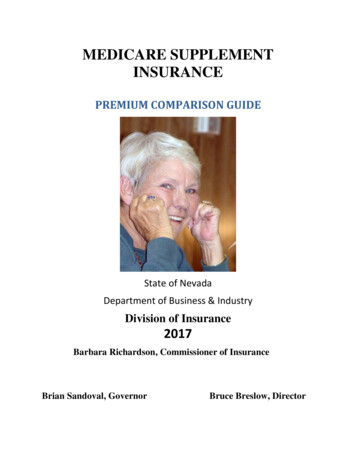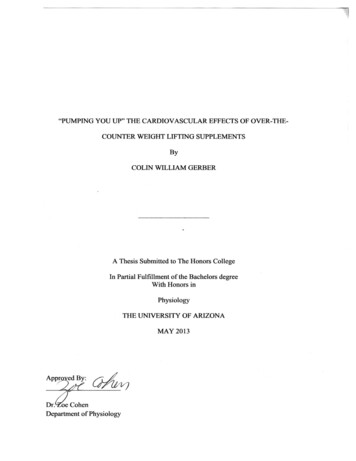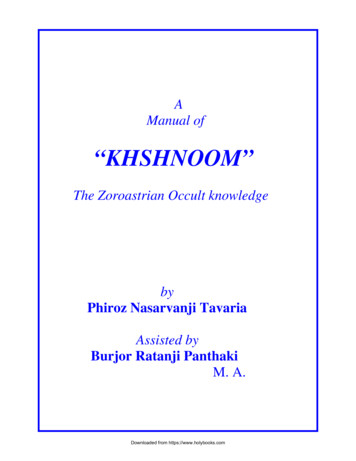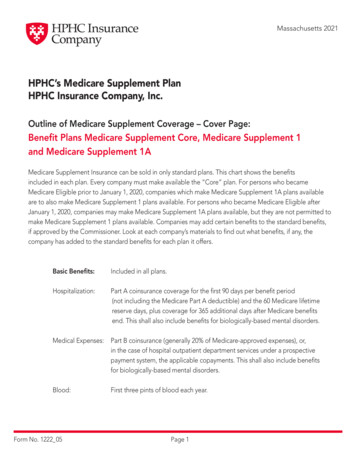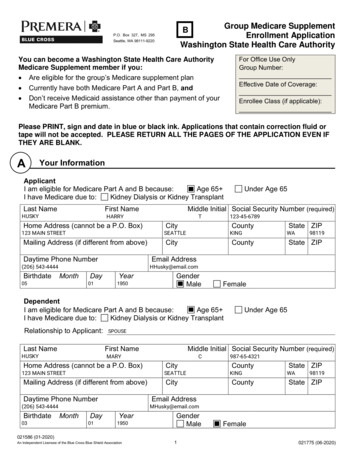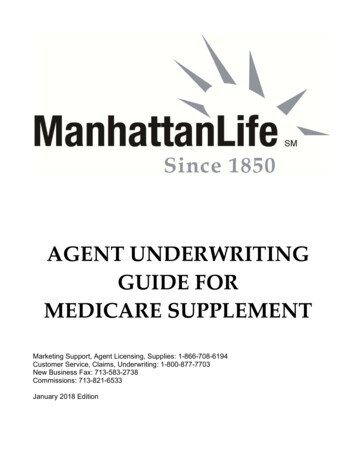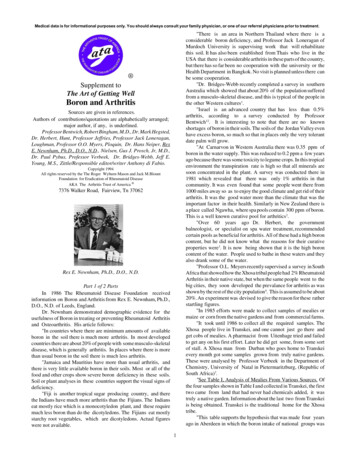
Transcription
Medical data is for informational purposes only. You should always consult your family physician, or one of our referral physicians prior to treatment."There is an area in Northern Thailand where there is aconsiderable boron deficiency, and Professor Jack Loneragan ofMurdoch University is supervising work that will rehabilitatethis soil. It has also been established from Thais who live in theUSA that there is considerable arthritis in these parts of the country,but there has so far been no cooperation with the university or theHealth Department in Bangkok. No visit is planned unless there canbe some cooperation."Dr. Bridges-Webb recently completed a survey in southernAustralia which showed that about 20% of the population sufferedfrom a musculo-skeletal disease, and this is typical of the people inthe other Western cultures1."Israel is an advanced country that has less than 0.5%arthritis, according to a survey conducted by ProfessorBentwich12. It is interesting to note that there are no knownshortages of boron in their soils. The soils of the Jordan Valley evenhave excess boron, so much so that in places only the very tolerantdate palm will grow."At Carnarvon in Western Australia there was 0.35 ppm ofboron in the water supply. This was reduced to 0.2 ppm a few yearsago because there was some toxicity to legume crops. In this tropicalenvironment the transpiration rate is high so that all minerals aresoon concentrated in the plant. A survey was conducted there in1981 which revealed that there was only 1% arthritis in thatcommunity. It was even found that some people went there from1000 miles away so as to enjoy the good climate and get rid of theirarthritis. It was the good water more than the climate that was theimportant factor in their health. Similarly in New Zealand there isa place called Ngawha, where spa pools contain 300 ppm of boron.This is a well known curative pool for arthritics2."Over 60 years ago Dr. Herbert, the governmentbalneologist, or specialist on spa water treatment, recommendedcertain pools as beneficial for arthritis. All of these had a high boroncontent, but he did not know what the reasons for their curativeproperties were3. It is now being shown that it is the high boroncontent of the water. People used to bathe in these waters and theyalso drank some of the water."Professor O.L. Meyers recently supervised a survey in SouthAfrica that showed how the Xhosa tribal people had 2% RheumatoidArthritis in their native state, but when the same people went to thebig cities, they soon developed the prevalance for arthritis as wasshown by the rest of the city population4. This is assumed to be about20%. An experiment was devised to give the reason for these ratherstartling figures."In 1985 efforts were made to collect samples of mealies ormaize or corn from the native gardens and from commercial farms."It took until 1986 to collect all the required samples. TheXhosa people live in Transkei, and one cannot just go there andget cobs of mealies. A pharmacist from Uitenhage tried and failedto get any on his first effort. Later he did get some, from some sortof stall. A Xhosa man from Durban who goes home to Transkeievery month got some samples grown from truly native gardens.These were analysed by Professor Verbeek in the Department ofChemistry, University of Natal in Pietermaritzburg, (Republic ofSouth Africa)5."See Table I, Analysis of Mealies From Various Sources. Ofthe four samples shown in Table I and collected in Transkei, the firsttwo came from land that had never had chemicals added, it wastruly a native garden. Information about the last two from Transkeiis being obtained. Transkei is the traditional home for the Xhosatribe."This table supports the hypothesis that was made four yearsago in Aberdeen in which the boron intake of national groups was Supplement toThe Art of Getting WellBoron and ArthritisSources are given in references.Authors of contributions\quotations are alphabetically arranged;major author, if any, is underlined.Professor Bentwich, Robert Bingham, M.D., Dr. Mark Hegsted,Dr. Herbert, Hunt, Professor Jeffries, Professor Jack Loneragan,Loughman, Professor O.O. Myers, Ploquin, Dr. Hans Neiper, RexE. Newnham, Ph.D., D.O., N.D., Nielsen, Gus J. Prosch, Jr, M.D.,Dr. Paul Pybus, Professor Verbeek, Dr. Bridges-Webb, Jeff E.Young, M.S., Zittle/Responsible editor/writer Anthony di Fabio.Copyright 1994All rights reserved by the The Roger Wyburn-Mason and Jack M.BlountFoundation for Eradication of Rheumatoid DiseaseAKA The Arthritis Trust of America 7376 Walker Road, Fairview, Tn 37062Rex E. Newnham, Ph.D., D.O., N.D.Part 1 of 2 PartsIn 1986 The Rheumatoid Disease Foundation receivedinformation on Boron and Arthritis from Rex E. Newnham, Ph.D.,D.O., N.D. of Leeds, England.Dr. Newnham demonstrated demographic evidence for theusefulness of Boron in treating or preventing Rheumatoid Arthritisand Osteoarthritis. His article follows:"In countries where there are minimum amounts of availableboron in the soil there is much more arthritis. In most developedcountries there are about 20% of people with some musculo-skeletaldisease, which is generally arthritis. In places where there is morethan usual boron in the soil there is much less arthritis."Jamaica and Mauritius have more than usual arthritis, andthere is very little available boron in their soils. Most or all of thefood and other crops show severe boron deficiency in these soils.Soil or plant analyses in these countries support the visual signs ofdeficiency."Fiji is another tropical sugar producing country, and therethe Indians have much more arthritis than the Fijians. The Indianseat mostly rice which is a monocotyledon plant, and these requiremuch less boron than do the dicotyledons. The Fijians eat mostlystarchy root vegetables, which are dicotyledons. Actual figureswere not available.1
Medical data is for informational purposes only. You should always consult your family physician, or one of our referral physicians prior to treatment.estimated on the grounds of observation of deficiency symptomsof foodstuff and on what analysis had been done. This is shown inthe following table6: "See Table II, Daily Boron Levels in Food, byNational Groups From this table it is seen that 5-6 mg of boron eachday is sufficient to maintain good health without arthritis. In 1967Ploquin published an article 'Boron in Foodstuffs'5 and he showshow the boron content of some common foods will vary from 1 to150 ppm, depending on the variety and the soil, but especially thefertilizer treatment of the soil. Some of the old crushed rockfertilizers had sufficient boron, but the newer synthetic typescontain none. Crops will remove from 30 to 300 g of boron perhectare. Grains remove the least while fruit trees and Cruciferaeremove the most. Most commercial crops are grown with fertilizer,and this means the minimum of boron, but those grown on gardensthat have never had fertilizer, but to which all wastes are returned,have the most. The South African work shows this very well."Ploquin did produce the following table III. Three additionalcolumns have been added which will give nearer to the actualquantity consumed by the average person in America, England orAustralia, New Zealand or South Africa in 19865. See Table III, IdealAmounts of Foodstuffs Consumed per Week"The revised daily intake of boron is below 2 mg as is consumedby some people in the English speaking countries. Most ingest only1-2 mg daily. There are large numbers of people who eat what isoften called junk foods, with well over the average for sugar,hamburger type meat meals, fried meat and eggs. Most of theircalories come from sugar and fat with no fruit or vegetables. As fruitaccounts for 65% of the revised boron intake, and fresh fruit andvegetables for 72% of Ploquin’s figure, people who eat this junkfood will ingest less than 2 mg boron daily, probably less than 1 mg."Ploquin does show that those who drink half a litre of wineeach day will take in much more boron, but that is more of aEuropean habit, and those who eat much fast food or take away foodsand junk foods will have much less."In 1979 there was a report of Dr. Rex E. Newnham claimingthat 'Boron Beats Arthritis'8. It was the first paper linking boron witharthritis and much work has been done since then. It is veryinteresting that boron compounds in concentrations as low as0.0005M will inhibit bacteriophages and protozoa, this was reported by Zittle in 19519. Other microorganisms are destroyed byhigher concentration.This [may ] give a reason for the success ofboron supplements in alleviating rheumatoid arthritis. Nielsen hasshown that boron seems to be able to effect calcium and magnesiummetabolism in the rat10. This agrees with Loughman’s work in whichhe showed that boron acted as a membrane catalyst to allow otherions to pass into the cell11. On this basis boron will allow ATP(adenosine tri-phosphate) to enter cells of worn-out cartilage orcollagen, so as to give energy for cell division, and thus to repairtissues, and so to overcome the effect of arthritis."There is increasing evidence that boron is an essential traceelement for both man and animal. It does influence calcium andmagnesium metabolism, and this is possibly through theparathyroid gland10. It does alleviate and seems to cure arthritiseither by acting [against whatever organism may cause RheumatoidDiseases] and/or as a membrane catalyst that permits repair ofdamaged cartilage and collagen."It has been shown by Professor Jeffries, an orthopaedicsurgeon at Otago Hospital, New Zeland, that patients who had beentaking the boron supplement had harder bones than the normalarthritic patient. This supports the work of Nielsen that boron doesinfluence calcium metabolism. We must get more evidence on thisand then it will probably be shown that lack of boron is one of themain causes of osteoporosis.Dr. Newnham’s hypothesis is making headway via physiciansand vitamin research organizations. His Osteo-traceTM, B-Alive, orBone Salts tablets have also helped the elderly, in Still's Disease,Juvenile Arthritis, and Lupus, especially in its severe form ofSystemic Lupus Erythematosus. Infants do require a reduced dose of1/4 to 1/2 tablet twice daily. [Newnham can be reached at CracoeHouse Cottage, Cracoe, Shipton, North Yorkshire, England BD236LB: Ed.]Other products, such as Vitamin Research Products ofMountain View, California, also recommend and sell Boron andalso Biotech, P.O. Box 1992, Fayetteville, AR 72702.It is interesting and helpful to compare Jeff E. Young's, (M.S.)article with Newnham's. I quote from Vitamin Research Products'nutritional newsletter, Volume 3, Number 5, August 1988:"BORON"Boron — Becoming Recognized asan Essential MineralPart 2 of 2 Parts"We have heard of the importance of micro-essentialminerals such as manganese, molybdenum, selenium, andvanadium. We know that calcium is required for sound bones. Nowresearch shows that boron may play a key role in the retention ofcalcium. But, what is boron? The latest study conducted by the U.S.Department of Agriculture indicated that within 8 days ofsupplementing 3 mg. of boron, a test group of postmenopausalwomen lost 40 percent less calcium, one-third less magnesium, andslightly less phosphorus through their urine. These are the mineralswhich make up our bones."Each day the women took a 3 mg. boron supplement in theform of sodium borate. They retained an average of 52 mg. morecalcium which is equal to a gram of calcium every 20 days. Thebody contains roughly 1100 grams of calcium, so over a period ofseveral years, that’s a significant savings in calcium."The absorption of calcium into our body is a verycomplicated process. it requires sex hormones, especially estrogen.This is the reason why menopausal women, whose ovaries are nolonger producing estrogen, have a hard time absorbing calcium.Even though many are taking a calcium supplement, most of thesupplemental calcium is wasted through urination. Currently,estrogen replacement is the only proven treatment for Osteoporosis, the brittle bone disease that affects millions." [See ChelationTherapy13 as well as Prevention and Treatment of Osteoporosis14;also note that, according to Gus Prosch, Jr, M.D., calcium shouldalways be taken with an equal amount of magnesium, and bothshould be in a form that is bio-available: Proper Nutrition forRheumatoid Arthritis.]"After the exciting discovery of calcium retention by a small boronsupplement, a question arises. How can boron make such adramatic difference? The answer is found in the blood serum ofthe experimental subjects. Researchers have discovered that theblood level of the most active form of estrogen — 17-betaestradiol — DOUBLES to the level found in women on estrogenreplacement therapy; that’s a fifty percent increase over the prestudy levels! Also, the blood levels of testosterone — a malehormone and precursor of estradiol — MORE than doubled."The researchers suspect that the body needs boron tosynthesize estrogen, vitamin D, and other steroid hormones. It mayalso protect these hormones against rapid breakdown. Another2
Medical data is for informational purposes only. You should always consult your family physician, or one of our referral physicians prior to treatment.3
Medical data is for informational purposes only. You should always consult your family physician, or one of our referral physicians prior to treatment.4
Medical data is for informational purposes only. You should always consult your family physician, or one of our referral physicians prior to treatment.mineral content if the cooking water is discarded."]"Table IIBoron Content in a Serving(mg. Boron per 100 ml).(3-1/3 fluid ounces or 0.42 cup)or 100 gr. (3-2/3 ounces, dry weight)Apple sauce, bottled0.279mgGrape Juice, bottled0.202mgApple Juice, bottled0.188mgPeaches, canned0.187mgBroccoli, frozen flower 0.185mgBroccoli, frozen stalks 0.089mgCherries, frozen0.147mgPears, canned0.122mgCarrots, canned0.075mgGreen beans, frozen0.046mgOrange juice, frozen0.041mgLettuce, iceberg0.039mgNoodles, egg0.037mgCornflakes, fortified0.031mgBread, white enriched 0.020mgIce cream, vanilla0.019mgPotatoes, canned0.017mgChicken breast, ground 0.005mgCoffee, freeze dried0.005mgRice, Minute0.003mgMilk, 2% fat0.002mgBeef, ground round * Not detectableCheese, cheddaror cream*Not detectableEggs, frozenNot detectableSugar, granulatedNot detectablestudy further substantiated this theory. A group of chickens werefed with a low vitamin D diet which normally would have stuntedtheir bone growth. However, this phenomenon has been haltedby the boron supplement, and the chickens are growing normally."Osteoporosis affects as many as 15 to 20 million olderAmericans predominately women. Each year Osteoporosiscontributes to about 1.3 million fractures (primarily in the hip, spineand wrist) in people 45 years old and over. This costs an estimated 3.8 billion annually [paid] to the medical industry."Calcium supplement sales are at an all-time high as women tryto prevent bone loss. Unfortunately, only a certain type of bone, thecortical bones (the outer, harder layer of bone), are beingstrengthened from the added calcium intake. But the trabecularbone loss (the spongy bone in the spine and distal forearm whereOsteoporosis frequently occurs) is not affected by calcium supplementation. Dr. Mark Hegsted, professor of Nutrition at HarvardUniversity, stated that 'Osteoporosis looks like a dietary problem,not a calcium problem.' You need magnesium, boron, phosphorus,silicon etc., as much as calcium for maintaining the healthy state ofall your bones."To make certain that boron can prevent or stopOsteoporosis, long term studies by monitoring bone mass whilesupplementing 3 mg. of boron per day will provide conclusiveevidence to prove the worthiness of this supplement. At this time,we are making a very educated assumption that calcium andmagnesium preserved by boron will end up saving our bones."Fruits and vegetables are rich in boron, especially apples,pears, nuts, leafy vegetables and legumes. The tables listed belowshow the boron content in some foods. As you can see, the averageboron intake can vary greatly in individuals depending on theirdaily diet. Some have only 0.2 mg. per day, while vegetarians mayconsume up to 20 mg. of boron per day. Based on animalexperiments, it seems reasonable that the human requirement forboron will be found to be near 1 to 2 mg. per day." [Dr. Newnhamsays: "Yet at this figure 90-100% of people develop arthritis if theylive long enough." 5-6 mg, he feels, is nearer to optimum: Ed.]"Since boron is rich in fruits and vegetables, the finding alsoindicates that vegetarians should have a much lower occurence ofosteoporosis. On the contrary, Eskimos, who eat almost no fruitsand vegetables, have a very high incidence of bone demineralization, even during their youth. Excessive phosphorus, which is foundin meat, also causes detrioration of bone (but that’s another story)."[Consider the impact on health of carbonated drinks with their highand, for some, continuous intake of phosphorus: Ed.]"Table IAverage Boron Content in DifferentFood GroupsFood GroupBoron(ug/g dry airy Products0.1-1.5ugVegetable foods (fresh)1.1-41ugVegetable foods (canned)0.4-2.0ugFruit0.8-3.8ugOther2.6ug"[Dr. Newhham says thatYoung has provided these figures asaverage boron contents of certain food groups; and that "it would bemuch more meaningful if the maximum and minimum figures werealso given. We should aim to get quality in our food, rather than alarge quantity of mediocre food. Processed foods, freezing, canningdo reduce the mineral contents. Even home cooking will reduce the* [These vary from Table I and so supports the need for maximum and minnimumvalues alongside average figures: Ed.][Dr. Newnham says, "There are 5 drinks and 20 foods in theabove list. Normal people do not eat this much in a day and the totalboron intake is [about] 1.7 mg. The only fresh and unprocessed foodis the lettuce. When the frozen foods are thawed in the manner doneby most people, much of the mineral content is lost."]Table 3Food With Highest Level ofBoron (In ug/g Fresh Weight)Soy eanut18ugHazel ure normally supplies boron in boric acid complex withsugar, polysaccharides, adenosine 5-phosphate, pyridoxine, riboflavin, dehydroascorbic acid and pyridine nucleotides."Postmenopausal women, aged 48 to 82 were equilibrated witha low boron diet for 119 days. When they were given 3 mg of boronas a supplement, their calcium excretion through urine decreased,and estradiol (estrogen) and testosterone in their blood serumincreased significantly.Furthermore, the responses were not temporary: The beneficial result of boron supplementation seems to last for as long as5
Medical data is for informational purposes only. You should always consult your family physician, or one of our referral physicians prior to treatment.why the more common forms of calcium do not perform as well asthe orotates and aspartates."Dr. Newnham states that the parathyroid gland containsmore boron than any other tissue in humans. Boron enhancesparathormone activity which is the prime organ controlling bonemineralization. Dr. Newnham’s research makes me now considerthat if arthritic patients are deficient in boron, there is a strongpossibility that the parathyroid bone mineralization effects are notfunctioning efficiently. By supplementing these patients withboron, could the patients be given regular forms of calcium such ascalcium carbonate and would they receive the same benefits as byusing the orotates and aspartates?"Dr. Newnham’s article also stimulated my imaginationconcerning the possible imbalance of certain anabolic hormonesin arthritics as well as the known deficiencies in osteoporosispatients such as 17- beta estradiol and testosterone. I havepreviously noted further improvement in treating many arthriticpatients and in nearly all osteoporosis patients when Isupplement these patients with small amounts of these anabolichormones. Dr. Newnham further documents a previous study byNielsen and Hunt which proved that a boron supplemented dietwith post-menopausal osteoporosis patients markedly reducedtheir urinary excretion of calcium and magnesium as well asgreatly elevated the serum concentrations of 17-beta estradiol and oftestosterone. The increase in the serum concentration of theseanabolic hormones may eventually prove, with further research, tobe the reason many arthritic patients respond in a more positivemanner to any therapy when they are given the hormones. It isobvious why osteoporosis patients respond better when given thesehormones."Dr. Newnham’s article confirmed other observations I havenoted in treating arthritic patients. For the past five years I have beena dedicated proponent of [The Rheumatoid Disease Foundationtreatment program]. Provided I adequately supplement thepatient’s diet with various nutritional suplements, I have experienced an eighty percent remission rate in these patients. . . . I have noticed that approximately sixty-five percent ofRheumatoid Arthritis patients and twenty-five to thirty percent ofosteoarthritic patients undergo the Herxheimer reaction whentreated with [The Rheumatoid Disease Foundation medications andThe Proper Nutrition for Rheumatoid Arthritis]. (See TheHerxheimer Effect15)"Dr. Newnham has in his research verified the fact thatarthritic patients undergoing treatment with Boron supplementation often experienced the Herxheimer reaction and the reactionis always a good prognostic sign."[In Dr. Newnham’s article],considerable evidence presented is strictly demographic in natureand this type of evidence [is not conclusive]. As I read the articlea second time, the demographic studies took on an entirelydifferent importance to me and I found the accumulatedinformation extremely interesting. All in all, I feel that Dr.Newnham did a remarkable job in collating and presenting thisinformation . . ."[Dr Newnham’s] article has some deficiencies andinadequacies but the merit and reasoning of the article far outweighsthe negative points. It is definitely not an illogical hypothesis andthe theory presented certainly does not conflict with present daythinking and especially from a nutritional standpoint. . . I believethe article will motivate further research from the publishedfindings."Rex Newnham, D.O., Ph.D., N.D.16, states: "As we use moreand more superphosphate on our food crops the availability of soilboron is decreased. It is estimated that most people in westernthe boron supplements are given."When the diet of the subjects contained adequatemagnesium, the effects of boron became less significant. The reasonis not yet fully understood."Even though there currently are no definitive answers for thetotal role of boron, the scientists who discovered the boron/calcium/estradiol connection suggest that boron may be crucial for theaddition of the hydroxyl (OH) group onto the hormones and vitaminD. The presence of hydroxyl groups make a big difference in theirhormonal characteristics. The differences between testosterone andestradiol (estrogen) are mainly determined by a single hydroxylgroup."Actually, vitamin D behaves more as a hormone, rather thanas a vitamin. The vitamin D which we get from food or from dietarysupplementation is not fully activated. It requires a conversion in theliver, and also another conversion in the kidney in order to becomefully active. This fully active vitamin D is called 1 alpha, 25dihydro-cholecalciferol. People with a poor liver and/or kidneyfunction are at a higher risk of getting Osteoporosis. As the nameof the active vitamin D implies, dihydro means two hydroxylgroups contained in each vitamin D molecule. They make a bigdifference when it comes to biological activity."In excess, boron is harmful to plants, livestock and humans.Boron inhibits many enzymatic activities with harmful effects.These enzymes include zanthine oxidase, alcohol dehydrogenase,alkaline phosphatase, catechol oxidase, polyphenol oxidase,tyrosinase, peroxidase, IAA oxidase, phosphoglucose isomerase,phosphaglucomutaseand phosphorylase (which inhibits starchsynthesis). Enzymes are the machinery of metabolism. When oneor more enzymes are hindered by toxic substances, the result canbe fatal."How much boron is toxic? We have discussed the estimationof boron requirement, which is about 2mg per day (0.000017ounces). Researchers found the lowest reported lethal dose of boricacid is about 45 gr. (1.6 ounce) for an adult and 2 gr. (0.07 ounces)for an infant." [This ends Young's paper. Dr. Newnham shows that6mg per day of boron (.000213 ounces) is necessary for good health:Ed.]Additional InformationSince Dr. Newnham's paper was sent to our physicians in1986, there has been considerably more research performed on theeffects of boron in various forms of arthritis.Gus J. Prosch, Jr., M.D., until his retirement one of our referralphysicians, was recently asked to review an article by Dr.Newnham entitled “Boron and Arthritis: Is There a Connection?” Ihave abstracted some of Prosch’s comments in review of thisarticle:"Dr. Newnham’s findings and research, if eventuallyconclusively proven, will serve to explain and possibly verifywith further research, certain unexplained observations I havemade in my own private practice when treating numerous patientswith Rheumatoid Arthritis, Osteoarthritis and Osteoporosis."In treating arthritic and osteoporotic patients, I consistentlyobserve better results when I supplement the diet of these patientswith either Calcium Orotate or Calcium Aspartate along withNorwegian Cod Liver Oil — which I feel is the best source ofnatural Vitamin D3. The D3 more efficiently helps regulate theexcessive excretion of calcium than the more commonly usedsynthetic vitamin D2. I’ve noticed that using Calcium Carbonateor other forms of calcium do not give the same consistent resultsas in the orotate or aspartate forms. Dr. Hans Neiper claims theorotate and aspartate forms of calcium carry the mineral directlyinto the cells to be utilized more efficiently. I have often wondered6
Medical data is for informational purposes only. You should always consult your family physician, or one of our referral physicians prior to treatment.societies ingest less than 2mg boron daily. This is based on theanalysis of school meals in the U.S.A.17, but analyses earlier in thiscentury put the figure at 8mg18."The prevalence of arthritis seems to follow inversely theavailability of boron in the soil. Jamaica has least boron and 70%with arthritis."Mauritius has very little and has much arthritis. NorthernThailand is very short of boron and has much arthritis but no figuresare available. In Fiji the Indians have much more arthritis than do theFijians, and the reason is that Indians eat mostly rice while Fijianseat mostly starchy root vegetables. Monocotyledons have muchlesser need for boron than do the dicotyledons."The Theory Behind Boron Metabolism"Based on work done at Oxford in the Agriculture Faculty19 itis believed that at the cellular level mineral metabolism is similarwith both plants and man. If this can be relied on, then boron is amembrane catalyst which allows various ions to pass through thecell membrane, particularly phosphates to support synthesis ofATP. This will give energy for efficient repair. It is obvious that inOsteoarthritis the cartilage is worn out, if it is because it lacks thenecessary energy for cell division, it explains the action of boron.Then in Rheumatoid Arthritis there is an autoimmune reaction forno known reason. It is suggested that the reason is that certaincollagen fibres are overage and cannot repair themselves,due to lackof energy-rich compounds within the cells."In an article entitled "Prevention is Better Than Cure The SadStory of Arthritis and Osteoporosis" by Rex E. Newnham, Ph.D.,D.O., N.D., Newnham has said, "It has been said that if we grow oldenough then we will all get arthritis. Old enough is generally in thefifties or sixties, but some survive to the eighties or nineties withoutany arthritis. In recent years, especially in some countries there aregrowing numbers of young children who develop juvenile arthritisor Still's desease; and some of these are even too young to walk. Justrecently a case was brought to my attention of a young girl aged 9months, but she was crying much and was evidently in pain, then itwas noticed that some of her joints were swollen and red. This wasjuvenile arthritis and we were able to cure her in 2 weeks usingmineral nutrients. The orthodox method would have been to give herpain killing drugs, in fact these are used for all arthritis."In America there are Poison Control Centres where every caseof poisoning is reported, and it is seen that analgesics or pain killingdrugs are responsible for many deaths each year. The latest figuresshow that these have died from taking analgesics in recent years asshown in brackets: 22 in 1983, 52 in 1984, 87 in 1985, 82 in 1986,93 in 1987, 118 in 1988, 126 in 1989, a total of 580 in 8 years andthe numbers seem to be increasing as time goes on. There is not muchhope for arthritics here."The latest of these analgesics are called NSAIDS or NonSpecific Anti-Inflammatory Drugs [also Non-steroidal Anti-Inflammatory Drugs] but they will induce stomach bleeding andulcers. The Food and Drug Administration admits that these drugscause 200,000 cases of gastric bleeding each year and many of thesehave to be hospitalised. Probably 2,000 of these die each year andthese drugs are mainly used for rheumatoid arthritis. We badly needsome good preventive for this disease."All our chronic diseases seem to be increasing and this is a badeffect of modern medical methods. Acute diseases can generally berelieved,
In 1986 The Rheumatoid Disease Foundation received information on Boron and Arthritis from Rex E. Newnham, Ph.D., D.O., N.D. of Leeds, England. Dr. Newnham demonstrated demographic evidence for the usefulness of Boron in treating or preventing Rheumatoid Arthritis and Osteoarthritis. His article follows:




